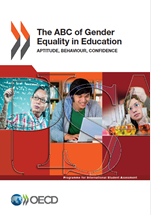PISA 2012 results: The ABC of Gender Equality in Education: Aptitude, Behaviour, Confidence
|
Many countries have been successful in closing gender gaps in learning outcomes. But even when boys and girls are equally proficient in mathematics and science, their attitudes towards learning and aspirations for their future are markedly different – and that has a significant
|
|
|
|
||
Contents |
||
Foreword, Executive Summary, Reader's Guide |
||
Chapter 1 |
Emerging gender gaps in education |
|
|
Emerging gender gaps in education examines trends in achievement among girls and boys and identifies the school subjects – and the specific sets of skills associated with those subjects – in which boys and girls appear to excel – or fail.
|
||
Chapter 2 |
Tackling underperformance among boys |
|
|
Tackling underperformance among boys examines gender differences in the activities in which boys and girls engage outside of school, in their ability to regulate their behaviour and emotions, in engagement with school and attitudes towards learning, and in the marks boys and girls receive in school. All of these ultimately have an impact on students’ futures, both in school and beyond.
|
||
Chapter 3 |
Girls' lack of self-confidence |
|
|
Girls' lack of self-confidence examines how girls’ lack of self-confidence in their own ability in science and mathematics may be responsible for the observed underachievement among girls in these subjects, particularly among highachieving girls. |
||
Chapter 4 |
Expectations and reality for school-leavers |
|
|
Expectations and reality for school-leavers explores the differences between 15-year-old boys’ and girls’ expectations for further education and their careers, and their preparedness to search for a job – and reveals whether adolescent expectations become reality after teenagers become adults. The chapter also describes young men’s and women’s levels of proficiency in literacy and numeracy after they leave compulsory schooling and examines gender differences in how adults use their skills at work. Financial literacy among 15-year-olds is also discussed. |
||
Chapter 5 |
How family, school and society affect boys' and girls' performance at school |
|
|
How family, school and society affect boys' and girls' performance at school examines various factors in the family, the school and throughout society that may be related to gender differences in student performance. These factors include the socio-economic status of a family and parents’ expectations for their child, the socio-economic profile of schools and teaching practices at school, and the level of gender equality in society.
|
||
Chapter 6 |
Policies and practices to help boys and girls fulfill their potential |
|
|
Policies and practices to help boys and girls fulfill their potential examines gender gaps in reading and mathematics performance from wider perspectives: across countries and over time. It also discusses the policy implications of the PISA findings that boys tend to underachieve in reading and high-performing girls tend to underachieve in mathematics and some areas of science and problem solving.
|
||
Annex A |
What some countries are doing to promote gender equality in education |
|
> Back to PISA 2012 Results for Volumes I, II, III, IV, V and VI
Related Documents



